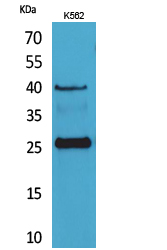产品名称
CD161 Rabbit Polyclonal Antibody
别名
KLRB1; CLEC5B; NKRP1A; Killer cell lectin-like receptor subfamily B member 1; C-type lectin domain family 5 member B; HNKR-P1a; NKR-P1A; Natural killer cell surface protein P1A; CD161
蛋白名称
Killer cell lectin-like receptor subfamily B member 1
存储缓冲液
Liquid in PBS containing 50% glycerol, 0.5% BSA and 0.02% New type preservative N.
Human Gene Link
http://www.ncbi.nlm.nih.gov/sites/entrez?db=gene&term=3820
Human Swissprot No.
Q12918
Human Swissprot Link
http://www.uniprot.org/uniprotkb/Q12918/entry
Mouse Gene Link
http://www.ncbi.nlm.nih.gov/sites/entrez?db=gene&term=100043861
Mouse Swissprot No.
Q0ZUP1
Mouse Swissprot Link
http://www.uniprot.org/uniprot/Q0ZUP1
Rat Gene Link
http://www.ncbi.nlm.nih.gov/sites/entrez?db=gene&term=689817
Rat Swissprot Link
http://www.uniprot.org/uniprot/Q0ZUP0
免疫原
The antiserum was produced against synthesized peptide derived from the Internal region of human KLRB1. AA range:101-150
特异性
CD161 Polyclonal Antibody detects endogenous levels of CD161 protein.
稀释度
WB 1:500 - 1:2000. ELISA: 1:20000. Not yet tested in other applications.
宿主
Polyclonal, Rabbit,IgG
背景介绍
Natural killer (NK) cells are lymphocytes that mediate cytotoxicity and secrete cytokines after immune stimulation. Several genes of the C-type lectin superfamily, including the rodent NKRP1 family of glycoproteins, are expressed by NK cells and may be involved in the regulation of NK cell function. The KLRB1 protein contains an extracellular domain with several motifs characteristic of C-type lectins, a transmembrane domain, and a cytoplasmic domain. The KLRB1 protein is classified as a type II membrane protein because it has an external C terminus. [provided by RefSeq, Jul 2008],
组织表达
Expressed in a subset of NK cells predominantly in intestinal epithelium and liver. Detected in peripheral blood T-cells and preferentially in adult T-cells with a memory antigenic phenotype.
细胞定位
Membrane ; Single-pass type II membrane protein .
功能
function:Plays an inhibitory role on natural killer (NK) cells cytotoxicity. Activation results in specific acid sphingomyelinase/SMPD1 stimulation with subsequent marked elevation of intracellular ceramide. Activation also leads to AKT1/PKB and RPS6KA1/RSK1 kinases stimulation as well as markedly enhanced T-cell proliferation induced by anti-CD3. Acts as a lectin that binds to the terminal carbohydrate Gal-alpha(1,3)Gal epitope as well as to the N-acetyllactosamine epitope. Binds also to CLEC2D/LLT1 as a ligand and inhibits NK cell-mediated cytotoxicity as well as interferon-gamma secretion in target cells.,induction:By IL12 in NK cells.,online information:NKRP1,PTM:N-glycosylated. Contains sialic acid residues.,similarity:Contains 1 C-type lectin domain.,subunit:Homodimer; disulfide-linked. Interacts with acid sphingomyelinase/SMPD1.,tissue specificity:Expressed in a subset of NK cells predominantly in intestinal epithelium and liver. Detected in peripheral blood T-cells and preferentially in adult T-cells with a memory antigenic phenotype.,
纯化
The antibody was affinity-purified from rabbit antiserum by affinity-chromatography using epitope-specific immunogen.


